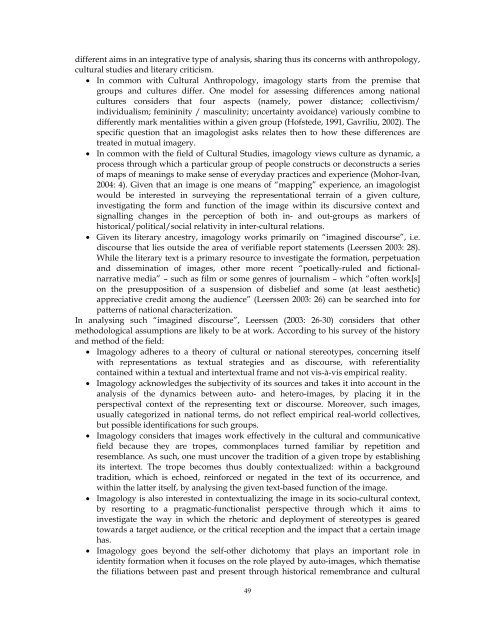You also want an ePaper? Increase the reach of your titles
YUMPU automatically turns print PDFs into web optimized ePapers that Google loves.
different aims in an integrative type of analysis, sharing thus its concerns with anthropology,<br />
cultural studies and literary criticism.<br />
� In common with Cultural Anthropology, imagology starts from the premise that<br />
groups and cultures differ. One mo<strong>de</strong>l for assessing differences among national<br />
cultures consi<strong>de</strong>rs that four aspects (namely, power distance; collectivism/<br />
individualism; femininity / masculinity; uncertainty avoidance) variously combine to<br />
differently mark mentalities within a given group (Hofste<strong>de</strong>, 1991, Gavriliu, 2002). The<br />
specific question that an imagologist asks relates then to how these differences are<br />
treated in mutual imagery.<br />
� In common with the field of Cultural Studies, imagology views culture as dynamic, a<br />
process through which a particular group of people constructs or <strong>de</strong>constructs a series<br />
of maps of meanings to make sense of everyday practices and experience (Mohor-Ivan,<br />
2004: 4). Given that an image is one means of “mapping” experience, an imagologist<br />
would be interested in surveying the representational terrain of a given culture,<br />
investigating the form and function of the image within its discursive con<strong>text</strong> and<br />
signalling changes in the perception of both in- and out-groups as markers of<br />
historical/political/social relativity in inter-cultural relations.<br />
� Given its literary ancestry, imagology works primarily on “imagined discourse”, i.e.<br />
discourse that lies outsi<strong>de</strong> the area of verifiable report statements (Leerssen 2003: 28).<br />
While the literary <strong>text</strong> is a primary resource to investigate the formation, perpetuation<br />
and dissemination of images, other more recent “poetically-ruled and fictionalnarrative<br />
media” – such as film or some genres of journalism – which “often work[s]<br />
on the presupposition of a suspension of disbelief and some (at least aesthetic)<br />
appreciative credit among the audience” (Leerssen 2003: 26) can be searched into for<br />
patterns of national characterization.<br />
In analysing such “imagined discourse”, Leerssen (2003: 26-30) consi<strong>de</strong>rs that other<br />
methodological assumptions are likely to be at work. According to his survey of the history<br />
and method of the field:<br />
� Imagology adheres to a theory of cultural or national stereotypes, concerning itself<br />
with representations as <strong>text</strong>ual strategies and as discourse, with referentiality<br />
contained within a <strong>text</strong>ual and inter<strong>text</strong>ual frame and not vis-à-vis empirical reality.<br />
� Imagology acknowledges the subjectivity of its sources and takes it into account in the<br />
analysis of the dynamics between auto- and hetero-images, by placing it in the<br />
perspectival con<strong>text</strong> of the representing <strong>text</strong> or discourse. Moreover, such images,<br />
usually categorized in national terms, do not reflect empirical real-world collectives,<br />
but possible i<strong>de</strong>ntifications for such groups.<br />
� Imagology consi<strong>de</strong>rs that images work effectively in the cultural and communicative<br />
field because they are tropes, commonplaces turned familiar by repetition and<br />
resemblance. As such, one must uncover the tradition of a given trope by establishing<br />
its inter<strong>text</strong>. The trope becomes thus doubly con<strong>text</strong>ualized: within a background<br />
tradition, which is echoed, reinforced or negated in the <strong>text</strong> of its occurrence, and<br />
within the latter itself, by analysing the given <strong>text</strong>-based function of the image.<br />
� Imagology is also interested in con<strong>text</strong>ualizing the image in its socio-cultural con<strong>text</strong>,<br />
by resorting to a pragmatic-functionalist perspective through which it aims to<br />
investigate the way in which the rhetoric and <strong>de</strong>ployment of stereotypes is geared<br />
towards a target audience, or the critical reception and the impact that a certain image<br />
has.<br />
� Imagology goes beyond the self-other dichotomy that plays an important role in<br />
i<strong>de</strong>ntity formation when it focuses on the role played by auto-images, which thematise<br />
the filiations between past and present through historical remembrance and cultural<br />
49












